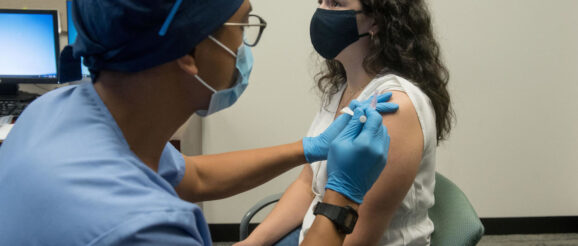Scientist behind mRNA vaccine innovation hails Pfizer breakthrough

A scientist who invented a technique that paved the way for Pfizer and BioNTech’s Covid-19 vaccine hailed the interim results announced by the companies Monday as “fantastic” and said the pioneering approach had a bright future.
Drew Weissman, an immunologist at the University of Pennsylvania, told AFP: “I can’t remember the last respiratory virus vaccine that has over 90 percent efficacy,” referring to the rate at which the companies said their injection protected people against the disease.
This is significantly higher than the 60-70 percent efficacy that had been mooted as possible by public health officials, and also much better than the 50 percent most influenza vaccines achieve — though the scientific community eagerly awaits the more detailed results.
Both the Pfizer vaccine and one being developed by Moderna together with the US National Institutes of Health use molecules called “messenger RNA” — an approach that has never before been brought to approval.
The idea was first demonstrated in 1990, but it wasn’t until the mid-2000s that Weissman and colleague Katalin Kariko developed a technique to control a dangerous inflammatory response seen in animals exposed to these molecules, opening the way to develop safe human vaccines.
Kariko is now a senior vice president at BioNTech, where Weissman serves as an advisor.
– Making the body a vaccine factory –
Vaccines work by training the body to recognize certain proteins, called “antigens,” that are made by disease-causing viruses or bacteria — priming the immune system to mount a response.
Traditional vaccines, like those for measles or the flu, do this by either injecting people with small amounts of the virus, or by giving them weaker “attenuated” forms of the virus.
“Those take a lot of time to develop and to optimize,” said Weissman.
By contrast, this newer type of vaccine delivers the genetic instructions to build the antigens directly into cells, so that the human body itself is effectively turned into a vaccine-making factory.
The Covid-19 vaccines based on mRNA make human cells grow an antigen of SARS-CoV-2, known as the “spike protein,” on their surface.
The immune system sees these spike proteins and develops infection-fighting “antibodies” against it, without ever exposing it to the actual virus.
– Fast and inexpensive –
Messenger RNA vaccines are thought to be safer than traditional vaccines, since there’s no chance that the spike protein in isolation can cause someone to get the disease, said Weissman.
Another advantage is speed: it can take scientists months to develop vaccines based on weakened viruses grown inside chicken eggs or common cell lines.
With mRNA vaccines, “the only thing you need is the sequence” of the antigen, said Weissman, which can take just a few weeks to find and construct.
Unlike traditional vaccines, the mRNA vaccines also provoke the production of immune cells, an additional defensive mechanism on top of antibodies.
– Future potential –
But a key disadvantage is that these vaccines have to be stored in specialist deep freezers, as opposed to refrigerator level temperatures required for some other vaccine platforms.
To date, no mRNA vaccines have been brought to approval for humans, but they have been in animals.
The Covid-19 pandemic has given the technology a huge boost thanks to massive public funding.
The US government under President Donald Trump signed a nearly $2 billion contract with Pfizer to deliver 100 million doses, should the vaccine be approved.
Moderna has likewise received $2.5 billion.
All these doses will be delivered to the United States, which hopes to start immunizing vulnerable people before the end of the year.
Weissman is upbeat about the platform’s future potential, telling AFP that development is already underway for herpes, influenza and HIV vaccines.
Nevertheless, he said, there is room to improve the high number of people who get side effects like arm pain, soreness and fever.
